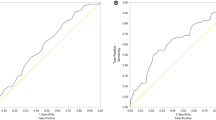Abstract
Behçet disease (BD) is an inflammatory illness that may attack several systems. Vascular involvement with thrombosis is one of the basic characteristics of this disease. The etiology of thrombosis tendency in BD has not been understood well. In this study, the role of primary coagulation parameters in patients with BD who have thromboembolic events was evaluated. In addition, the relation between the clinical activity of the disease and these parameters was compared. A total of 96 patients with a diagnosis of BD were studied at Ankara University, Medical School, Department of General Surgery and Behçet Center. BD patients were separated into two groups with respect to vascular involvement. Group A contained 22 patients with vascular attacks, and group B contained 74 patients without vascular attacks. In addition, 25 healthy persons comprised the control group (group C). The coagulation parameters assessed included protein C, protein S, antithrombin III activity, fibrinogen level, prothrombin time (PT), and partial thromboplastin time (PTT). There were no differences among the three groups with respect to protein C, protein S, fibrinogen, PT, and PTT values (p > 0.05). The antithrombin III value was found to be high in BD patients compared to those in the control group (p= 0.011). There was no difference regarding the antithrombin III value between BD patients with or without vascular attacks (p= 0.954). There was no correlation between the activity of disease and coagulation parameters (p > 0.05), but a positive correlation was seen between the duration of illness and vascular involvement. Fifty percent of patients who had had BD more than 8 years had vascular involvement (p= 0.002). We could not determine a specific pathology in relation to coagulation parameters that could explain the etiology of thrombosis in patients with BD. The elevated antithrombin III levels in patients with BD (compared to controls) may be due to a compensatory defense mechanism against increased procoagulant activity. There was a correlation between the duration of illness and vascular involvement.
Similar content being viewed by others
Author information
Authors and Affiliations
Rights and permissions
About this article
Cite this article
Şengül, N., Demirer, S., Yerdel, M. et al. Comparison of Coagulation Parameters for Healthy Subjects and Behçet Disease Patients with and without Vascular Involvement. World J. Surg. 24, 1584–1588 (2000). https://doi.org/10.1007/s002680010282
Published:
Issue Date:
DOI: https://doi.org/10.1007/s002680010282




